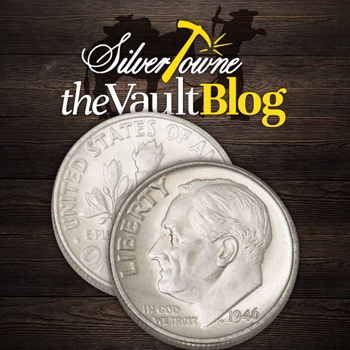
What do a couple of big time vintage commemoratives, the Roosevelt dime, and the obverse of the Franklin half dollar have in common? Their designer, John R. Sinnock. Known as one of the greatest coin engravers to have ever served the United States Mint, he was a prime example of how far United States coinage had come since its very beginnings.
Born in Raton, New Mexico in July of 1888, Sinnock was interested in a number of different arts and had a flair for sculpture at an early age. Throughout his childhood and young adult years, his seriousness about art and design developed into a passion he would pursue as he attended the Philadelphia Museum School of Industrial Art to further his talents.
After earning his degree in 1913 in Normal Art Instruction, he started making quite the name for himself within the local art community. He became a member of both the Philadelphia Sketch Club and the Philadelphia Alliance while also attending the Pennsylvania Academy where he produced a number of portrait medals. Some of those medals included famous individuals such as President Herbert Hoover, Thomas Edison, and Charles Dickens. As his portfolio continued to diversify and gain momentum, Sinnock landed a teaching and instructor job not only at the school he graduated from but also at Western Reserve University where he taught for 10 years.
A Career At the United States Mint
After teaching arts for a number of years, it was then that Sinnock was hired as an assistant sculptor by Chief Engraver George T. Morgan and later became the Assistant Chief Engraver in 1923.
Some of Sinnock’s first works were vintage commemorative half dollars. His very first work though was a collaboration with George T. Morgan and involved the 1918 Illinois Centennial Half Dollar. While Morgan designed the obverse that features one of the most decorated President’s of the United States and for sure the most decorated individual to come out of Illinois, Abraham Lincoln, Sinnock designed the reverse which was modeled after the Illinois State seal. It features an eagle with a shield in its talon and a ribbon with the words “State Sovereignty National Union” in its beak. This commemorative today is a classic representation of vintage commemoratives as a whole.
Just a few short years after being named Assistant Chief Engraver, John R. Sinnock was named the eighth Chief Engraver of the United States Mint as George T. Morgan passed in 1925.
Eighth Chief Engraver of the United States
A year into his chief engraver status, Sinnock was tasked to design a commemorative coin to celebrate the 150th anniversary of the signing of the Declaration of Independence. From this came the popular 1926 Sesquicentennial American Independence Silver Half Dollar which was presented at the Sesquicentennial International Exposition in Philadelphia on July 4, 1926. He also designed the 1926 Sesquicentennial American Independence Gold $2.5 Quarter Eagle for the celebration.
Perhaps Sinnock’s most admirable work came when he was asked to take part in the redesign of the Purple Heart military medal. He was one of three different sculptors commissioned as he sculpted the plaster models and eventually was chosen as the winning sculptor. Although not the designer, John R. Sinnock is recognized as making refinements and modeling the medal.
During the 1940s, the country was being led by President Franklin D. Roosevelt. During his presidency, he passed in 1945 and his commemoration took place immediately. Roosevelt’s active participation with the March of Dimes was the reason the dime was chosen and his profile is still seen of the coin today. John R. Sinnock was chosen by the Mint Director to create this commemoration and is given full credit for both the obverse and reverse of the dime. It was officially released in 1946 on what would have been Roosevelt’s 64th birthday.
Sinnock’s last design credit would come when he was asked to design a new half dollar in 1946. The requirement? To feature Benjamin Franklin. Sinnock was able to get the obverse of the coin done before he passed in May of 1947. The following chief engraver, Gilroy Roberts, was able to finish the coin and it was officially released in April of 1948.
Sinnock passed and was remembered for being one of the greatest engravers to have produced for the Mint. Much of his works were donated to a collection in Luxembourg Museum in Paris, The American Numismatic Society in New York, and the National Museum in Washington, D.C.







